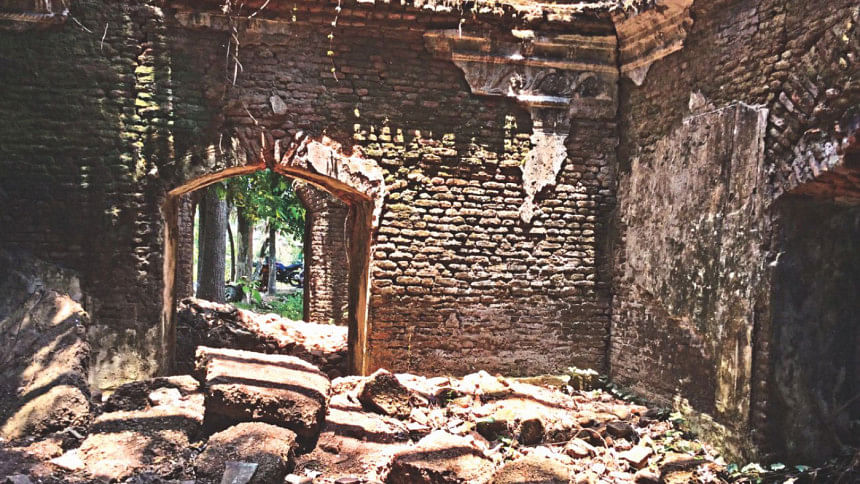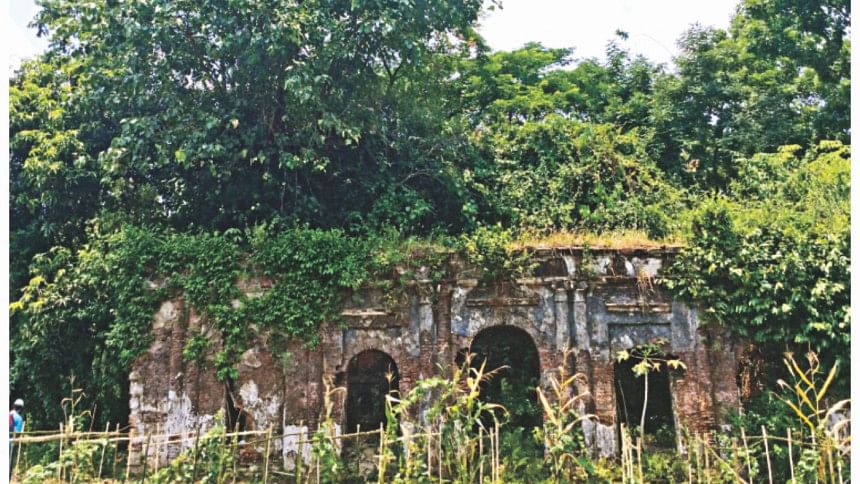A palace in ruins

A two-storey dilapidated building covered in moss and weeds is losing a war against age and is now barely a testimony to its rich historic past in a remote village of Rangunia upazila.
About two centuries old and built during the colonial era, the crumbling structure was once the palace of a Chakma king, even though it is located in the plains of Razanagar union, almost 33 kilometres away from incumbent Chakma King Debasish Roy's residence in Sadar upazila of Rangamati.
The protruding bricks on the walls and the large chunks of stones lying on the ground stand as evidence to the lost Chakma kingdom which once stretched from Alikadam, Bandarban in the south to the Feni river in the north, the Lusai Hills in the West to the Dhaka Trunk Road in the east.
"It attracts hundreds of visitors in the remote village every day. The building, aged around 250 years, might have been built by Chakma Queen Kalindi or some earlier king,” said Rumel Dewan, who is looking after the property owned by King Debasish Roy.
As there is no stone inscription, there are different accounts about its age. Some say it was built during Chakma Queen Kalindi's reign between 1844 and 1870.
However, Regional Director of Department of Archaeology Md Amiruzzaman believes the building is much older than that.
He said a stone inscription on a nearby Buddhist temple mentions that Queen Kalindi built the temple to increase the aesthetic beauty of the palace. So, the palace is older than the temple, he added.
"The inscription provides description of the Chakma kings from King Shermosto Khan, who ruled from 1737 to 1758 and was the first king to accept subjugation to the Mughals," said Amiruzzaman.
Biraj Mohan Dewan in his book "Chakma Jatir Itibritto” mentions a legend about mid-17th century Chakma King Dhormya, who fell in love and married the daughter of a Mughal nobleman. Their son Mogollya, who became the king in 1684, named his sons Suvol Khan and Jollal alias Fotey Khan.
Shermusto Khan was Fotey Khan's son.
Since Mogollya's reign, many Chakma kings and noblemen took the title Khan, but there is no evidence they converted to Islam.

"An account says Shermosto Khan's adopted son Sukdeb established a capital in the plains of Rangunia upazila and built that palace. So, based on the historic accounts and stone inscriptions, it could be reckoned that it was built between 1737 and 1776 either by Chakma King Shermusto Khan or his son Sukdeb Roy," said Amiruzzaman.
During a recent visit, it was found that the entire building has been covered in weeds. Large cracks have developed on the three-foot-wide walls and the roof crumbled down completely. Yet the original structure of the lost glory is evident.
The rectangular east-facing building is 52 feet long and 48 feet wide. It has 10 rooms including three on the second floor. The building, built with brick, lime and mortar, has arched doors in each room. Besides, there were flower and vine motifs on the wall that could still be seen.
But the palace is on the verge of complete destruction as no initiatives, neither by its owner nor by the government, have been taken to preserve it.
Amiruzzaman suggests that the building be preserved under the Antiquities Act, 1968. "Besides, The Department of Environment and tourism authorities could work together to make it a cultural tourism site with a museum in the area," he observed.
According to the Antiquities Act, 1968 (amended in 1976), any ancient monument (minimum 100 years old) illustrative of architecture, warfare, politics or culture can be regarded as an article of antiquity.
Department of Archaeology Chittagong region Deputy Director Lovely Yeasmin said a report was sent to Dhaka in 2013 with suggestion to declare the building as 'protected.'
More moss and weeds gather on the palace walls as a decision is still pending.

 For all latest news, follow The Daily Star's Google News channel.
For all latest news, follow The Daily Star's Google News channel. 



Comments